WebTutor - Thomson Learning
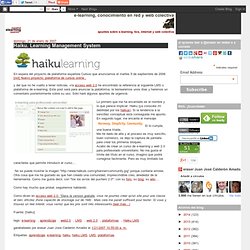
e-learning, conocimiento en red y web2.0: Haiku. Learning Mangement System
En espera del proyecto de plataforma española Cursoo que anunciamos el martes 5 de septiembre de 2006 [not] Nuevo proyecto: plataforma de cursos online , y del que no he vuelto a tener noticias, vía acceso web 2.0 he encontrado la referencia al siguiente LMS o plataforma de e-learning. Este post será para anunciar la plataforma, la testearemos unos días y haremos un comentario posteriormente sobre su uso. Sólo haré algunos apuntes de urgencia. Lo primero que me ha encantado es el nombre y lo que parece implicar: Haiku (ya conocéis mi debilidad por los haikus). Si lo cumple, una buena tríada.Me he dado de alta y el proceso es muy sencillo, buen comienzo, os dejo la captura de pantalla para crear los primeros bloques.Acabo de crear un curso de e-learning y web 2.0 para profesorado universitario. Otra cosa que me ha gustado es que han creado una comunidad, imprescindible creo, alrededor de la herramienta. Como hay mucho que probar, seguiremos hablando. Fuente: [haiku] tags: e-learning , web2.0
New York, NY and London (Dec. 28, 2012) – NOOK Media, LLC, a subsidiary of Barnes & Noble, Inc. (NYSE: BKS), the leading retailer of content, digital media and educational products, today announced that Pearson (NYSE:PSO), the world’s leading learning company, has agreed to make a strategic investment in NOOK Media, LLC. Pearson has agreed to invest $89.5 million in cash in NOOK Media, LLC at a post-money valuation of approximately $1.789 billion in exchange for preferred membership interests representing 5% equity stake. Following the closing of the transaction, Barnes & Noble will now own approximately 78.2% of the NOOK Media subsidiary and Microsoft, which also holds preferred membership interests, will own approximately 16.8%. Subject to certain conditions, Pearson will earn the option to purchase up to an additional five percent ownership in NOOK Media. About Barnes & Noble, Inc. Barnes & Noble, Inc. About NOOK Media LLC About Pearson Forward-Looking Statements Media Contacts
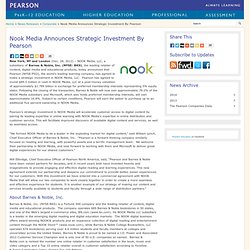
Pearson | Always Learning
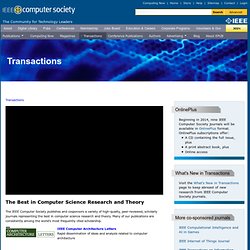 The IEEE Computer Society publishes and cosponsors a variety of high-quality, peer-reviewed, scholarly journals representing the best in computer science research and theory. Many of our publications are consistently among the world's most frequently cited scholarship. IEEE Computer Architecture LettersRapid dissemination of ideas and analysis related to computer architecture IEEE Transactions on Cloud ComputingInnovative research ideas and applications results in all areas relating to cloud computing IEEE Transactions on ComputersLeading worldwide innovation and technical excellence in computers IEEE Transactions on Dependable and Secure ComputingLeading forum for innovative research on information and system security IEEE Transactions on Emerging Topics in ComputingCovering aspects of computer science, computing technology, and computing applications not currently covered by other IEEE Computer Society Transactions Link takes you off computer.org
The IEEE Computer Society publishes and cosponsors a variety of high-quality, peer-reviewed, scholarly journals representing the best in computer science research and theory. Many of our publications are consistently among the world's most frequently cited scholarship. IEEE Computer Architecture LettersRapid dissemination of ideas and analysis related to computer architecture IEEE Transactions on Cloud ComputingInnovative research ideas and applications results in all areas relating to cloud computing IEEE Transactions on ComputersLeading worldwide innovation and technical excellence in computers IEEE Transactions on Dependable and Secure ComputingLeading forum for innovative research on information and system security IEEE Transactions on Emerging Topics in ComputingCovering aspects of computer science, computing technology, and computing applications not currently covered by other IEEE Computer Society Transactions Link takes you off computer.org
IEEE Transactions on Learning Technologies
 Adaptive capacity is increasingly recognized as essential for maintaining the resilience of social–ecological systems and for coping with environmental change. Four main requirements enable societies to successfully adapt to change: (1) the will and intention to maintain social–ecological resilience, (2) knowledge about current problems and the desired direction of change, (3) proactive behavior, and (4) the capacity to change existing patterns of behavior. The adaptive capacity of societies can be greatly enhanced by fostering the adaptive capacity of their individual members. Considerable knowledge about how to foster the adaptability of individuals exists in the science of education and in cognitive and social psychology. 1Institute of Rural Sciences, University of Wales, Aberystwyth, Ceredigion SY23 3AL, UK 2Oxford Learning Institute, University of Oxford, Oxford OX1 1PT, UK 3Fenner School of Environment and Society, Australian National University, Canberra 0200, Australia S.A. R.
Adaptive capacity is increasingly recognized as essential for maintaining the resilience of social–ecological systems and for coping with environmental change. Four main requirements enable societies to successfully adapt to change: (1) the will and intention to maintain social–ecological resilience, (2) knowledge about current problems and the desired direction of change, (3) proactive behavior, and (4) the capacity to change existing patterns of behavior. The adaptive capacity of societies can be greatly enhanced by fostering the adaptive capacity of their individual members. Considerable knowledge about how to foster the adaptability of individuals exists in the science of education and in cognitive and social psychology. 1Institute of Rural Sciences, University of Wales, Aberystwyth, Ceredigion SY23 3AL, UK 2Oxford Learning Institute, University of Oxford, Oxford OX1 1PT, UK 3Fenner School of Environment and Society, Australian National University, Canberra 0200, Australia S.A. R.
Adaptive capacity and learning to learn as leverage for social–ecological resilience
Learner Centred Learning/Adult Learning Theories, Principles and Practices/Kolb’s Learning Cycle
From WikiEducator David Kolb’s work developed from the influences of John Dewey, Kurt Lewin and Jean Piaget. Kolb’s Learning Cycle reflects an experiential way of learning identifying 4 main aspects of learning Concrete experience Reflective observation Abstract conceptualisation Active experimentation These aspects are ordered in a cyclical model to indicate a continuous process. Expanding on the original model Kolb worked with D. Convergent - practical application of ideas Divergent - imaginative ability and generation of ideas Assimilation - creating theoretical models and making sense of disparate observations Accommodative - Carrying out plans and tasks that involve them in new experiences Although learners may have a preference for a particular learning style it was still suggested that all four aspects needed to be incorporated for effective learning (Fry, Ketteridge & Marshall, 1999). Below are links to a variety of viewpoints and information on Kolb’s Experiential Learning Cycle.
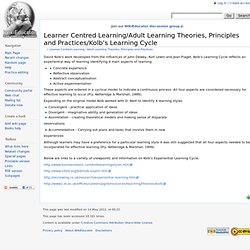
Learning with Kernels
I've been giving this some consideration lately as I've found myself populating and repopulating a couple of machines at home and work with all that I require to keep me happy. So, here they are: 1. I have Google on almost permanent standby, especially so now (see 10). 2. I'm also a fan of it's capabilities for laying out eBooks for publishing to PDF. Occasionally I also use it for {gasp} knocking together presentations though, ironically, I think it rather sucks at that. 3. iGoogle(Personal) This is my blog reader of choice. 4. 5. I have a Samson CO1u USB microphone. 6. 7. Blogs are obviously great ways to consolidate personal learning, but as it is such a great CMS I think that it lends itself exceptionally well to broadcasting content of a non-blog nature, or with multiple authors, as the centrepiece of an informal learning network. 8. 9. 5-clicks(Creating) There are lots of little apps that I use for special specific tasks when developing, mostly around colour and screengrabs. 10.

Learning Rocks: elearning
Foundation: Learn More and Get Goodies
Networked Learning » SlideShare
Handheld Learning 2008
Learning Objects - Learning About Learning Objects.url
lams Learning Activity Management System.url
Posted on July 12th, 2010. Over the last several months I have been in many meetings with HR and L&D professionals talking about the enormous power of formalized informal learning. As we walk through out enterprise learning framework and talk with people about the need to expand their concept of training, I am reminded of the work we did back in 2003 and 2004 when I wrote The Blended Learning Book® (which is just as important to understand today as ever before). Here are a few of the jewels I want to remind everyone to consider. 1. As one considers all the various aspects of training and education, the ultimate measure of learning is achieving some level of “mastery.” A simple way to think about is the following equation (from the Blended Learning Book): MASTERY = PROFICIENCY (which comes from training) + RETENTION (which comes from practice) The word “proficiency” means that you “know the subject” – you can pass a test and are proficient. 2. 3. 4. So my point is simple. Like this:
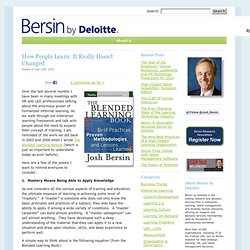
» Blog Archive » How People Learn It Really Hasn’t Changed.url
Lucas Learning
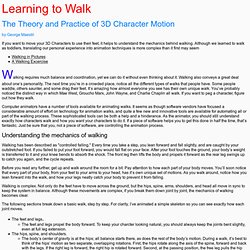
Learning to Walk: Dv April 1997
Learning to Walk The Theory and Practice of 3D Character Motion by George Maestri If you want to move your 3D Characters to use their feet, it helps to understand the mechanics behind walking. Although we learned to walk as toddlers, translating our personal experience into animation techniques is more complex than it first may seem Walking requires much balance and coordination, yet we can do it without even thinking about it. Computer animators have a number of tools available for animating walks. Understanding the mechanics of walking Walking has been described as "controlled falling." Before you read any further, get up and walk around the room for a bit. Walking is complex. The following sections break down a basic walk, step by step. The feet and legs. Animating a walk Now that you understand the underlying mechanics, you can attempt to animate a walk. The first thing you need to concern yourself with is the timing of the walk. Keeping your feet on the ground To cycle or not to cycle?
What is e-Learning?
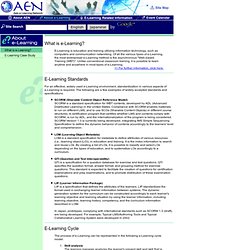 What is e-Learning? E-Learning is education and training utilizing information technology, such as computers and communication networking. Of all the various types of e-Learning, the most widespread e-Learning method is the asynchronous "Web-based Training (WBT)". Unlike conventional classroom training, it is possible to learn anytime and anywhere in most types of e-Learning. E-Learning Standards For an effective, widely used e-Learning environment, standardization in various aspects of e-Learning is required. SCORM (Sharable Content Object Reference Model) SCORM is a standard specification for WBT contents, developed by ADL (Advanced Distributed Learning) in the United States. E-Learning Cycle The process of e-Learning can be represented in the following e-Learning cycle model.
What is e-Learning? E-Learning is education and training utilizing information technology, such as computers and communication networking. Of all the various types of e-Learning, the most widespread e-Learning method is the asynchronous "Web-based Training (WBT)". Unlike conventional classroom training, it is possible to learn anytime and anywhere in most types of e-Learning. E-Learning Standards For an effective, widely used e-Learning environment, standardization in various aspects of e-Learning is required. SCORM (Sharable Content Object Reference Model) SCORM is a standard specification for WBT contents, developed by ADL (Advanced Distributed Learning) in the United States. E-Learning Cycle The process of e-Learning can be represented in the following e-Learning cycle model.
E-Learning Essentials | Is Online Learning For You? Traits of Successful Online Students
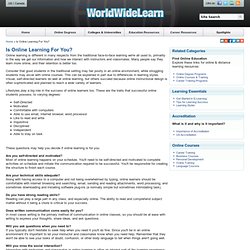 Online learning is different in many respects from the traditional face-to-face learning we're all used to, primarily in the way we get our information and how we interact with instructors and classmates. Many people say they learn more online, and their retention is better too. Consider that good students in the traditional setting may fair poorly in an online environment, while struggling students may excel with online courses. This can be explained in part due to differences in learning styles. Lifestyles play a big role in the success of online learners too. Self-DirectedMotivatedComfortable with computersAble to use email, internet browser, word processorLike to read and writeInquisitiveDisciplinedIndependentAble to stay on task These questions may help you decide if online learning is for you: Are you self-directed and motivated? Are your technical skills adequate? Do you have strong reading skills? Does written communication come easily for you? Will you ask questions when you need to?
Online learning is different in many respects from the traditional face-to-face learning we're all used to, primarily in the way we get our information and how we interact with instructors and classmates. Many people say they learn more online, and their retention is better too. Consider that good students in the traditional setting may fair poorly in an online environment, while struggling students may excel with online courses. This can be explained in part due to differences in learning styles. Lifestyles play a big role in the success of online learners too. Self-DirectedMotivatedComfortable with computersAble to use email, internet browser, word processorLike to read and writeInquisitiveDisciplinedIndependentAble to stay on task These questions may help you decide if online learning is for you: Are you self-directed and motivated? Are your technical skills adequate? Do you have strong reading skills? Does written communication come easily for you? Will you ask questions when you need to?
A listing of websites and publications that will guide you to information on LD/ADHD, teaching, professionals in the field, disability rights and advocacy, and government agencies and resource centers. LD Journal LDA’s technical publication oriented toward professionals in the field of learning disabilities. The journal is a vehicle for disseminating the most current thinking on learning disabilities and to provide information on research, practice, theory, issues, and trends regarding learning disabilities from the perspectives of varied disciplines involved in broadening the understanding of learning disabilities. Guides & Booklets Informational booklets available online or for download. Resources on Teaching & Learning The resources listed provide a selection of websites with the latest information on teaching and learning. Learning Disabilities/ADHD Information Resources Professional Organizations State Resources A listing of disability-related resources in each state. Research
Resources - Learning Disabilities Association of America
Resources - Learning Disabilities Association of America
Rapid e-learning today e learning Rapid Collaborative Atlantic Link
The page you are looking for might have been removed, had its name changed, or is temporarily unavailable. Please try the following: Technical Information (for support personnel) Go to Microsoft Product Support Services and perform a title search for the words HTTP and 404.Open IIS Help, which is accessible in IIS Manager (inetmgr), and search for topics titled Web Site Setup, Common Administrative Tasks, and About Custom Error Messages.
Learning Styles Quiz Image Search Results
Felder & Soloman: Learning Styles and Strategies
Richard M. Felder Hoechst Celanese Professor of Chemical Engineering North Carolina State University Barbara A. Soloman Coordinator of Advising, First Year College North Carolina State University Active learners tend to retain and understand information best by doing something active with it--discussing or applying it or explaining it to others. Reflective learners prefer to think about it quietly first. Everybody is active sometimes and reflective sometimes. How can active learners help themselves? If you are an active learner in a class that allows little or no class time for discussion or problem-solving activities, you should try to compensate for these lacks when you study. How can reflective learners help themselves? If you are a reflective learner in a class that allows little or no class time for thinking about new information, you should try to compensate for this lack when you study. Everybody is sensing sometimes and intuitive sometimes. How can sensing learners help themselves?
Overview of learning styles
Many people recognize that each person prefers different learning styles and techniques. Learning styles group common ways that people learn. Everyone has a mix of learning styles. Using multiple learning styles and �multiple intelligences� for learning is a relatively new approach. By recognizing and understanding your own learning styles, you can use techniques better suited to you. The Seven Learning Styles Visual (spatial):You prefer using pictures, images, and spatial understanding. Why Learning Styles? Your learning styles have more influence than you may realize. Research shows us that each learning style uses different parts of the brain. For example: Visual: The occipital lobes at the back of the brain manage the visual sense. Where to next? Click the links in the navigation menu on the left (or above) to learn more about the individual learning styles, or go to the learning styles inventory page to try a test to discover your own learning styles.
U.S.A. Learns
Learning Telecollaboratively - Learning Telecollaboratively
Reusable Learning
Blogging 2 Learn, Learning 2 Blog
The Role of the Learning Advisor in Promoting Autonomy | Learner Autonomy in Language Learning
(Published in Learner Autonomy in Language Learning ( January 2011) Jo Mynard, Kanda University of International Studies, Japan (jomynard@gmail.com) Download PDF version This paper was presented as part of the Plenary Symposium “Tomorrow’s learners, tomorrow’s teachers: Autonomous development in English language learning and teaching” at the Japan Association of College English Teachers (JACET) 49th annual convention in Sendai, Japan. September 9th 2010. My contribution to this symposium will be to comment on the role of a learning advisor in promoting learner autonomy. 1. Firstly, I need to say that the title “Learning advisor” is by no means universal. My colleague Luke Carson and I have developed the following broad definition: “Advising in language learning is the process of assisting students in directing their own paths in order to become better, more autonomous language learners” (Carson & Mynard, forthcoming) Do you want to hear a surprising fact? 2. 3.
learning « LifelongLearner Rhonda’s Weblog
Additional needs and mental health
Learning and learning difficulties
Scaffolding children’s learning


 e-learning, conocimiento en red y web2.0: Haiku. Learning Mangement System
En espera del proyecto de plataforma española Cursoo que anunciamos el martes 5 de septiembre de 2006 [not] Nuevo proyecto: plataforma de cursos online , y del que no he vuelto a tener noticias, vía acceso web 2.0 he encontrado la referencia al siguiente LMS o plataforma de e-learning. Este post será para anunciar la plataforma, la testearemos unos días y haremos un comentario posteriormente sobre su uso. Sólo haré algunos apuntes de urgencia. Lo primero que me ha encantado es el nombre y lo que parece implicar: Haiku (ya conocéis mi debilidad por los haikus). Si lo cumple, una buena tríada.Me he dado de alta y el proceso es muy sencillo, buen comienzo, os dejo la captura de pantalla para crear los primeros bloques.Acabo de crear un curso de e-learning y web 2.0 para profesorado universitario. Otra cosa que me ha gustado es que han creado una comunidad, imprescindible creo, alrededor de la herramienta. Como hay mucho que probar, seguiremos hablando. Fuente: [haiku] tags: e-learning , web2.0
e-learning, conocimiento en red y web2.0: Haiku. Learning Mangement System
En espera del proyecto de plataforma española Cursoo que anunciamos el martes 5 de septiembre de 2006 [not] Nuevo proyecto: plataforma de cursos online , y del que no he vuelto a tener noticias, vía acceso web 2.0 he encontrado la referencia al siguiente LMS o plataforma de e-learning. Este post será para anunciar la plataforma, la testearemos unos días y haremos un comentario posteriormente sobre su uso. Sólo haré algunos apuntes de urgencia. Lo primero que me ha encantado es el nombre y lo que parece implicar: Haiku (ya conocéis mi debilidad por los haikus). Si lo cumple, una buena tríada.Me he dado de alta y el proceso es muy sencillo, buen comienzo, os dejo la captura de pantalla para crear los primeros bloques.Acabo de crear un curso de e-learning y web 2.0 para profesorado universitario. Otra cosa que me ha gustado es que han creado una comunidad, imprescindible creo, alrededor de la herramienta. Como hay mucho que probar, seguiremos hablando. Fuente: [haiku] tags: e-learning , web2.0
 Pearson | Always Learning
Pearson | Always Learning
 The IEEE Computer Society publishes and cosponsors a variety of high-quality, peer-reviewed, scholarly journals representing the best in computer science research and theory. Many of our publications are consistently among the world's most frequently cited scholarship. IEEE Computer Architecture LettersRapid dissemination of ideas and analysis related to computer architecture IEEE Transactions on Cloud ComputingInnovative research ideas and applications results in all areas relating to cloud computing IEEE Transactions on ComputersLeading worldwide innovation and technical excellence in computers IEEE Transactions on Dependable and Secure ComputingLeading forum for innovative research on information and system security IEEE Transactions on Emerging Topics in ComputingCovering aspects of computer science, computing technology, and computing applications not currently covered by other IEEE Computer Society Transactions Link takes you off computer.org
IEEE Transactions on Learning Technologies
The IEEE Computer Society publishes and cosponsors a variety of high-quality, peer-reviewed, scholarly journals representing the best in computer science research and theory. Many of our publications are consistently among the world's most frequently cited scholarship. IEEE Computer Architecture LettersRapid dissemination of ideas and analysis related to computer architecture IEEE Transactions on Cloud ComputingInnovative research ideas and applications results in all areas relating to cloud computing IEEE Transactions on ComputersLeading worldwide innovation and technical excellence in computers IEEE Transactions on Dependable and Secure ComputingLeading forum for innovative research on information and system security IEEE Transactions on Emerging Topics in ComputingCovering aspects of computer science, computing technology, and computing applications not currently covered by other IEEE Computer Society Transactions Link takes you off computer.org
IEEE Transactions on Learning Technologies
 Adaptive capacity is increasingly recognized as essential for maintaining the resilience of social–ecological systems and for coping with environmental change. Four main requirements enable societies to successfully adapt to change: (1) the will and intention to maintain social–ecological resilience, (2) knowledge about current problems and the desired direction of change, (3) proactive behavior, and (4) the capacity to change existing patterns of behavior. The adaptive capacity of societies can be greatly enhanced by fostering the adaptive capacity of their individual members. Considerable knowledge about how to foster the adaptability of individuals exists in the science of education and in cognitive and social psychology. 1Institute of Rural Sciences, University of Wales, Aberystwyth, Ceredigion SY23 3AL, UK 2Oxford Learning Institute, University of Oxford, Oxford OX1 1PT, UK 3Fenner School of Environment and Society, Australian National University, Canberra 0200, Australia S.A. R.
Adaptive capacity and learning to learn as leverage for social–ecological resilience
Adaptive capacity is increasingly recognized as essential for maintaining the resilience of social–ecological systems and for coping with environmental change. Four main requirements enable societies to successfully adapt to change: (1) the will and intention to maintain social–ecological resilience, (2) knowledge about current problems and the desired direction of change, (3) proactive behavior, and (4) the capacity to change existing patterns of behavior. The adaptive capacity of societies can be greatly enhanced by fostering the adaptive capacity of their individual members. Considerable knowledge about how to foster the adaptability of individuals exists in the science of education and in cognitive and social psychology. 1Institute of Rural Sciences, University of Wales, Aberystwyth, Ceredigion SY23 3AL, UK 2Oxford Learning Institute, University of Oxford, Oxford OX1 1PT, UK 3Fenner School of Environment and Society, Australian National University, Canberra 0200, Australia S.A. R.
Adaptive capacity and learning to learn as leverage for social–ecological resilience

 Learning Rocks: elearning
Learning Rocks: elearning
 » Blog Archive » How People Learn It Really Hasn’t Changed.url
» Blog Archive » How People Learn It Really Hasn’t Changed.url
 Learning to Walk: Dv April 1997
Learning to Walk The Theory and Practice of 3D Character Motion by George Maestri If you want to move your 3D Characters to use their feet, it helps to understand the mechanics behind walking. Although we learned to walk as toddlers, translating our personal experience into animation techniques is more complex than it first may seem Walking requires much balance and coordination, yet we can do it without even thinking about it. Computer animators have a number of tools available for animating walks. Understanding the mechanics of walking Walking has been described as "controlled falling." Before you read any further, get up and walk around the room for a bit. Walking is complex. The following sections break down a basic walk, step by step. The feet and legs. Animating a walk Now that you understand the underlying mechanics, you can attempt to animate a walk. The first thing you need to concern yourself with is the timing of the walk. Keeping your feet on the ground To cycle or not to cycle?
Learning to Walk: Dv April 1997
Learning to Walk The Theory and Practice of 3D Character Motion by George Maestri If you want to move your 3D Characters to use their feet, it helps to understand the mechanics behind walking. Although we learned to walk as toddlers, translating our personal experience into animation techniques is more complex than it first may seem Walking requires much balance and coordination, yet we can do it without even thinking about it. Computer animators have a number of tools available for animating walks. Understanding the mechanics of walking Walking has been described as "controlled falling." Before you read any further, get up and walk around the room for a bit. Walking is complex. The following sections break down a basic walk, step by step. The feet and legs. Animating a walk Now that you understand the underlying mechanics, you can attempt to animate a walk. The first thing you need to concern yourself with is the timing of the walk. Keeping your feet on the ground To cycle or not to cycle?
 What is e-Learning? E-Learning is education and training utilizing information technology, such as computers and communication networking. Of all the various types of e-Learning, the most widespread e-Learning method is the asynchronous "Web-based Training (WBT)". Unlike conventional classroom training, it is possible to learn anytime and anywhere in most types of e-Learning. E-Learning Standards For an effective, widely used e-Learning environment, standardization in various aspects of e-Learning is required. SCORM (Sharable Content Object Reference Model) SCORM is a standard specification for WBT contents, developed by ADL (Advanced Distributed Learning) in the United States. E-Learning Cycle The process of e-Learning can be represented in the following e-Learning cycle model.
What is e-Learning? E-Learning is education and training utilizing information technology, such as computers and communication networking. Of all the various types of e-Learning, the most widespread e-Learning method is the asynchronous "Web-based Training (WBT)". Unlike conventional classroom training, it is possible to learn anytime and anywhere in most types of e-Learning. E-Learning Standards For an effective, widely used e-Learning environment, standardization in various aspects of e-Learning is required. SCORM (Sharable Content Object Reference Model) SCORM is a standard specification for WBT contents, developed by ADL (Advanced Distributed Learning) in the United States. E-Learning Cycle The process of e-Learning can be represented in the following e-Learning cycle model.
 Online learning is different in many respects from the traditional face-to-face learning we're all used to, primarily in the way we get our information and how we interact with instructors and classmates. Many people say they learn more online, and their retention is better too. Consider that good students in the traditional setting may fair poorly in an online environment, while struggling students may excel with online courses. This can be explained in part due to differences in learning styles. Lifestyles play a big role in the success of online learners too. Self-DirectedMotivatedComfortable with computersAble to use email, internet browser, word processorLike to read and writeInquisitiveDisciplinedIndependentAble to stay on task These questions may help you decide if online learning is for you: Are you self-directed and motivated? Are your technical skills adequate? Do you have strong reading skills? Does written communication come easily for you? Will you ask questions when you need to?
Online learning is different in many respects from the traditional face-to-face learning we're all used to, primarily in the way we get our information and how we interact with instructors and classmates. Many people say they learn more online, and their retention is better too. Consider that good students in the traditional setting may fair poorly in an online environment, while struggling students may excel with online courses. This can be explained in part due to differences in learning styles. Lifestyles play a big role in the success of online learners too. Self-DirectedMotivatedComfortable with computersAble to use email, internet browser, word processorLike to read and writeInquisitiveDisciplinedIndependentAble to stay on task These questions may help you decide if online learning is for you: Are you self-directed and motivated? Are your technical skills adequate? Do you have strong reading skills? Does written communication come easily for you? Will you ask questions when you need to?